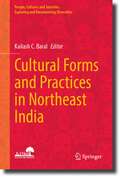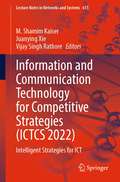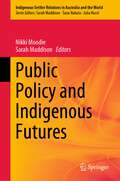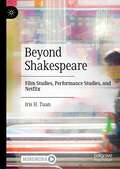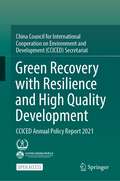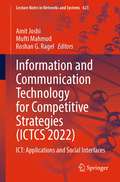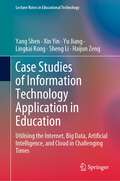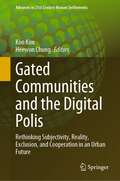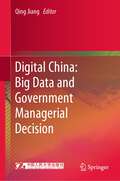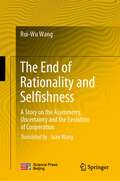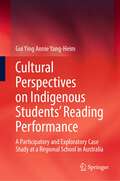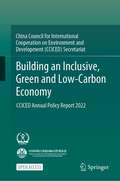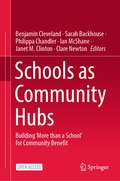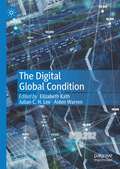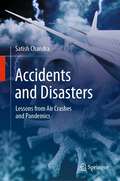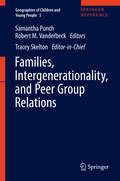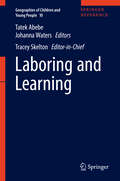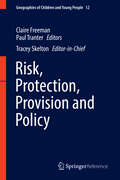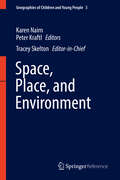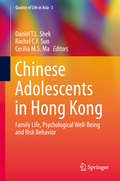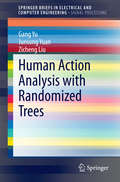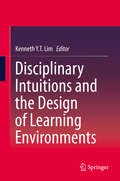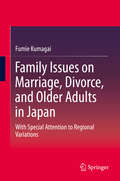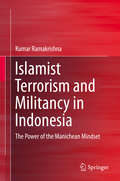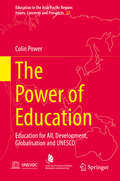- Table View
- List View
Cultural Forms and Practices in Northeast India (People, Cultures and Societies: Exploring and Documenting Diversities)
by Kailash C. BaralThe present book examines cultural diversities of Northeast India. The sixteen essays included in the volume cover various aspects of cultural forms and their practices among the communities of Northeast. The present volume is expected to serve as a bridge between vanishing cultural forms and their commodification, on the one hand, and their cultural ritual origins, evolution and significance in identity formation, on the other. The book analyses continuity of cultural forms, their representations and often their reinventions under globalisation. Further, the book underlines historical forces such as colonialism and religious conversion that have transformed communities and their cultural practices. Yet some of the pre-colonial, ritual-performative traditions hold on. Through insightful analyses, this book offers an informed view of the region’s historical, ethnic and cultural practices. It is expected that the volume will be useful for scholars and students interested in Northeast studies.
Information and Communication Technology for Competitive Strategies: Intelligent Strategies for ICT (Lecture Notes in Networks and Systems #615)
by M. Shamim Kaiser Juanying Xie Vijay Singh RathoreThis book contains best selected research papers presented at ICTCS 2022: Seventh International Conference on Information and Communication Technology for Competitive Strategies. The conference will be held in Chandigarh, India, during December 9–10, 2022. The book covers state-of-the-art as well as emerging topics pertaining to ICT and effective strategies for its implementation for engineering and managerial applications. This book contains papers mainly focused on ICT for computation, algorithms and data analytics and IT security. The work is presented in two volumes.
Public Policy and Indigenous Futures (Indigenous-Settler Relations in Australia and the World #4)
by Nikki Moodie Sarah MaddisonThis book focuses on Indigenous self-determined and community-owned responses to complex socioeconomic and political challenges in Australia, and explores Indigenous policy development and policy expertise. It critically considers current practices and issues central to policy change and Indigenous futures. The book foregrounds the resurgence that is taking place in Indigenous governing and policy-making, providing case studies of local and community-based policy development and implementation. The chapters highlight new Australian work on what is an international phenomenon.This book brings together senior and early career political scientists and policy scholars, and Indigenous and non-Indigenous scholars working on problems of Indigenous policy and governance.
Beyond Shakespeare: Film Studies, Performance Studies, and Netflix
by Iris H. TuanWith joy and grace to accompany the readers to have the translocal tour to visit about thirty-seven works, this monograph applies the academic critical theories of Performance Studies, Film Studies, Psychoanalysis, Postmodernism, and Visual Culture, to interpreting the special selection works. The focus and common theme are on race, body, and class. With the background of COVID-19 since 2019 up to the present, the book offers the readers with the remarkable insight of human beings’ accumulated wisdom and experiences in surviving with the dreadful diseases like the plagues in Shakespeare’s time. After the supreme reading, may the global readers in the world acquire the knowledge and power to live in sustainability with education and entertainment of films, performances, and online streaming Netflix TV dramas.
Green Recovery with Resilience and High Quality Development: CCICED Annual Policy Report 2021
by CCICEDThis open access book is based on the research outputs of China Council for International Cooperation on Environment and Development (CCICED) in 2021. It covers major topics of Chinese and international attention regarding green development, such as climate, biodiversity, ocean, BRI, urbanization, sustainable production and consumption, technology, finance, value chain, and related topics. It also reviews the progress of China‘s environmental and development policies and the impacts from CCICED. This is a highly informative and carefully presented book, providing insight for policy makers in environmental issues.
Information and Communication Technology for Competitive Strategies: ICT: Applications and Social Interfaces (Lecture Notes in Networks and Systems #623)
by Amit Joshi Mufti Mahmud Roshan G. RagelThis book contains best selected research papers presented at ICTCS 2022: Seventh International Conference on Information and Communication Technology for Competitive Strategies. The conference will be held in Chandigarh, India during 9 – 10 December 2022. The book covers state-of-the-art as well as emerging topics pertaining to ICT and effective strategies for its implementation for engineering and managerial applications. This book contains papers mainly focused on ICT for computation, algorithms and data analytics and IT security. The work is presented in two volumes.
Case Studies of Information Technology Application in Education: Utilising the Internet, Big Data, Artificial Intelligence, and Cloud in Challenging Times (Lecture Notes in Educational Technology)
by Yang Shen Xin Yin Yu Jiang Lingkai Kong Sheng Li Haijun ZengThis book includes 43 case studies showcasing the application of basic education informatization. It shares the experiences of 43 schools in the construction and application of educational informatization in various regions in China. It aims to promote the balanced development of education and expand the coverage of quality education resources. This book also highlights the achievements of these schools in constructing school-based resources, and changing teaching modes and optimizing classroom teaching. This collection of case studies not only reflects the current trend of informatization application moving from 'universal application' to 'integrated innovation' but also uncovers the potential of applying information technology to transform education processes, innovate education environment, and optimize education governance.
Gated Communities and the Digital Polis: Rethinking Subjectivity, Reality, Exclusion, and Cooperation in an Urban Future (Advances in 21st Century Human Settlements)
by Kon Kim Heewon ChungThis edited collection provides an alternative discourse on cities evolving with physically and virtually networked communities—the ‘digital polis’—and offers a variety of perspectives from the humanities, media studies, geography, architecture, and urban studies. As an emergent concept that encompasses research and practice, the digital polis is oriented toward a counter-mapping of the digital cityscape beyond policing and gatekeeping in physical and virtual gated communities. Considering the digital polis as offering potential for active support of socially just and politically inclusive urban circumstances in ways that mirror the Greek polis, our attention is drawn towards the interweaving of the development of digital technology, urban space, and social dynamics. The four parts of this book address the formation of technosocial subjectivity, real-and-virtual combined urbanity, the spatial dimensions of digital exclusion and inclusion, and the prospect of emancipatory and empowering digital citizens. Individual chapters cover varied topics on digital feminism, data activism, networked individualism, digital commons, real-virtual communalism, the post-family imagination, digital fortress cities, rights to the smart city, online foodscapes, and open-source urbanism across the globe. Contributors explore the following questions: what developments can be found over recent decades in both physical and virtual communities such as cyberspace, and what will our urban future be like? What is the ‘digital polis’ and what kinds of new subjectivity does it produce? How does digital technology, as well as its virtuality, reshape the city and our spatial awareness of it? What kinds of exclusion and cooperation are at work in communities and spaces in the digital age? Each chapter responds to these questions in its own way, navigating readers through routes toward the digital polis.Chapter "Introduction - The digital polis and its practices: Beyond gated communities" is available open access under a Creative Commons Attribution 4.0 International License via link.springer.com.
Digital China: Big Data and Government Managerial Decision
by Qing JiangThis book is the first practical case study on the application of big data in China's government management scenarios, which is important for comprehensively presenting the achievements of China's e-government and digital construction as well as deeply understanding the implementation of big data strategy in China.The author of this book is one of the earliest practitioners engaged in the study of big data applications, and has personally experienced the development, major events, application cases, and industry changes of big data in China. Cases in this book are all actual projects carried out. The author of this book explains the development history of big data she has personally experienced, presenting in an easy-to-understand way the basic concept and characteristics of big data and practical interpretation, which provides important reference for the practical work of government and enterprise managers. The application ideas of big data in management innovation are proposed, and scenarios are described and discussed in terms of accelerating research on sharing big data in government affairs, breaking barriers, realizing data flow information sharing, creating one-stop services, improving the corresponding policy system for sharing big data in government affairs, building public information platform for e-government, and strengthening network and information infrastructure.Especially for the government personnel in departments, this book will give them a better understanding of the charm and value of big data, intuitively understand the utilization and analysis of big data, carry out effective government management and make correct decisions, so as to improve the data literacy of organizations and individuals, form scientific support for their own government's decision-making and management, thus promote the continued construction of digital government, digital China, and digital economy era based on the application of big data.
The End of Rationality and Selfishness: A Story on the Asymmetry, Uncertainty and the Evolution of Cooperation
by Rui-Wu WangThis book reviews the antinomy of rationality and selfishness raised from egoism, though rationality and selfishness are understood as basic evolutionary dynamics of humans and other organisms in both classical economics and evolutionary biology. Based on the research and a comparison with human’s social cooperative behavior, the author presents his belief that the social cooperative system, in its essence, cooperation and conflict are of uncertain stochasticity resulting from their intrinsic asymmetric interaction between cooperative partners. The book then discusses limitations of Newton’s methodology of monism in both biology and social science. The understanding of the asymmetric and uncertain characteristics found in cooperation system needs perspective of quantum physics of pluralism. At the end of the book, the author undertakes a review of consistency of Newtonian and monism philosophy and the links between quantum physics and pluralism philosophy.
Cultural Perspectives on Indigenous Students’ Reading Performance: A Participatory and Exploratory Case Study at a Regional School in Australia
by Gui Ying Yang-HeimThis book explores the contextual, particularly cultural-related, factors that may impact reading outcomes of young Indigenous learners in their early years, underpinned by the conceptual framework of cultural capital originated by Bourdieu. By drawing upon a participatory and exploratory case study, conducted at a regional school in Australia over a period of six months, it highlights the challenges that Indigenous students face in reading, and how the contextual factors contribute to Indigenous students’ development in reading skills and their reading performance. This book helps readers to gain a better and deeper understanding of Indigenous culture, the importance of the role that culture plays in Indigenous children’s literacy education, and how it shapes the way they learn and think.
Building an Inclusive, Green and Low-Carbon Economy: CCICED Annual Policy Report 2022
by CCICEDThis open access book introduces the major environmental green development issues from six major themes carbon neutrality, nature-based solution, watershed management and climate adaptation, BRI green development, sustainable food supply chain, ecosystem-based integrated ocean management focusing on the progress of China’s environment and development policies from 2021 accomplishments. It is based on the research outputs of CCICED in the year of 2021, which marks China’s start point of implementation of its 14th Five-Year Plan when world economy also strived to recover from the pandemic.
Schools as Community Hubs: Building ‘More than a School’ for Community Benefit
by Benjamin Cleveland Sarah Backhouse Philippa Chandler Ian McShane Janet M. Clinton Clare NewtonThis open access book brings together research on the planning, design, governance and management of schools as community hubs—places that support the development of better-connected, more highly integrated, and more resilient communities with education at the centre. It explores opportunities and difficulties associated with bringing schools and communities closer together, with a focus on the facilities needed to accommodate shared experiences that generate social capital and deliver reciprocal benefits.This book discusses the expanded roles of schools, and investigates how schools may offer more to their communities—historically, currently and into the future—with respect to the role of the built environment in situating community activities and services.Organised around four sections, it showcases important areas of development in the field via an interdisciplinary approach, which weaves together empirical research with theoretical insights and practical examples. This book not only highlights the challenges associated with the development of schools as community hubs but offers evidence-based insights into how to overcome such hurdles to develop community-facing schools into the future.
The Digital Global Condition
by Elizabeth Kath Julian C. H. Lee Aiden WarrenThis book explores how globalization and ubiquity of digital technology combine to create specific global impacts, challenges and opportunities. Although globalization is already associated with the speeding up of interactions and change, digital globalization is characterized by immediacy. The utter pervasiveness opens new global vulnerabilities at international, national, social and personal levels. The Digital Global Condition examines the nature of digital globalization, enabling us to not only inhabit a digital world, but also to understand it, even to live well in it.
Accidents and Disasters: Lessons from Air Crashes and Pandemics
by Satish ChandraThis book deals with the contemporary subject of perception of risk and its influence on accidents and disasters. The contents examine the conventional viewpoints on human errors, incubation of errors, complexity and organisational deviance as a cause for accidents. Work of Mary Douglas with regard to risk, Charles Perrow's work on the normal accident theory and Diane Vaughn's theory on normalisation of deviance are examined from a fresh perspective in this book. It also discusses prominent accidents in aviation, space, nuclear energy, automotive and healthcare, using the pandemic and Boeing 737 Max as a backdrop to study accidents and disasters. It further explores the background and similarities to these events and addresses the core issues such as the state of regulation, the worldview of the sociologists, and proposes that mental models of complex systems, avarice and risk for gain as other possibilities for accidents. Using the concept of nudge in behavioural economics and the Elinor Ostrom’s viewpoint on regulating for common good, it suggests a way forward through the High Reliability Organisation Theory (HRO) leading to enhanced risk perception. The book will be of interest to those who would like to understand the need to incorporate risk perception into regulation, engineers and scientists, professionals and policy makers working in the areas of disaster and risk management, technology areas like aviation, nuclear plants, space and healthcare, students of the sociology of risk and of course the general reader.
Families, Intergenerationality, and Peer Group Relations
by Samantha Punch Robert M. Vanderbeck Tracey SkeltonThis volume addresses children and young people’s relationships both within and beyond the context of the family. It begins with familial relationships and the home by examining the social and cultural complexities of families, intimacies and interdependencies, including the dynamics of families as spatial units (nuclear, multi-generational, alternative) and the roles that children play (as carers etc.). In addition to considering child/parent relations, sibling relationships and birth order, the initial section includes particular dimensions of children's familial relationships in diverse contexts, such as family food practices, aspirations and work practices. The second section explores geographical dimensions of adult/child relationships beyond the dynamics of the family and across the lifecourse. It considers the roles that intergenerationality plays in children's and young people's lives as well as their links with wider communities. The section addresses broader conceptual issues and themes (child-adult relationships outside the home; intergenerational geographies and spaces; and the intergenerational city) while also providing more focused discussions of current issues related to the geographies of intergenerationality including adoption, looked after children and fertility. The final section addresses children and young people's relationships with one another: friendship, peer group relations, and sexualities. It explores the geographies and spatialities of affective relations and emotional practices among children and young people. Geographies of bodies and embodiment and their connection to identities is an important part of this section. The chapters range from cross-cultural comparisons of age mixing among children to specific kinds of relationship formations between children and young people (e.g. friendship; sexual relations; gangs; bullying) and the spaces and places (including cyberspace) that facilitate, impede and organise these relationships. The diverse relationships that children and young people form with both one another and with adults have significant geographical dimensions.
Laboring and Learning
by Tatek Abebe Johanna WatersThis volume incorporates ground-breaking new academic perspectives on the contributions that children and young people make to societies around the world, with a particular focus on learning and work. The chapters in the volume offer conceptual and empirical insights into how young people learn to labour, and the complex social, spatial, temporal, institutional and relational processes that informs their engagements in daily, generational and social reproduction. The editors have intentionally avoided using the terms 'education' and 'employment' in the title, as this volume is an attempt to capture the multitude of ways, spaces and contexts (not just 'formal') in which learning takes place and work is carried out. Here, learning indicates education in the broadest possible sense, to incorporate not just formal schooling and the acquisition of institutionally recognised academic knowledge and credentials, but also informal learning (including socialization and the on-the-job acquisition of skills that takes place almost imperceptibly, over time). In addition to the theoretical perspectives this volume brings on young people's education and work, other prominent conceptual themes present throughout the work are mobilities, transitions and gender. Following four initial chapters that engage with conceptual issues, the remainder of the volume is divided into two sections, entitled 'spaces of labouring and learning' and 'livelihoods, transitions and social reproduction'. Within these sections, a broad spectrum of empirical chapters demonstrates how young people live, learn and labour in Africa, Asia, Europe and Latin America. These include, among others, geographies of education; interface between migration, learning and livelihoods; cultural politics of human capital formation; schooling and work; citizenship education; families and parenting; socialization and informal education; education-induced migration; processes and practices of inclusion and exclusion in educational institutions; part-time work; domestic work; care work; informal livelihoods; entrepreneurship; social transitions; and a wide range of social, economic, cultural, political (structural) forces that intersect and dissect these topics. As the reader will become aware, there is no such thing as a standard educational or work trajectory, a 'normal' transition or a straight forward relationship between work, education and social reproduction. Indeed, one of the aims of the volume is deliberately to showcase the diversity that young people's lives hold in this regard.
Risk, Protection, Provision and Policy
by Tracey Skelton Paul Tranter Claire FreemanThe volume provides an overview of recent research (within geography and allied disciplines) around the overarching concept of 'safe and accessible places of encounter'. It develops according to three interrelated themes. The first part of the volume examines several of the many spaces children use and that are relevant to the geographies of children and young people including: the city centre and inner city high rise housing, urban versus suburban and rural spaces, local neighbourhoods, the 'home' (for particular groups of children and young people such as child domestic workers in Bangladesh), school playgrounds, services (such as domestic violence shelters), outdoor natural spaces, and "life space" (where music and arts are presented in a non-political space in Bosnia-Herzegovina). The second part examines how notions of safety, protection and risk relate to providing children and young people with good life chances, and accessible spaces that enhance or reduce well-being. This middle section emphasises the debate about risk and the need to balance risk and safety/protection. The final part focuses on policy that builds on the provision/identification of spaces, safety/protection and risk. The emphasis is on how policy at different levels (international-national-local-family) helps provide better spaces of encounter and enhances life chances for children and young people. This section also recognises the different levels of policy making associated with different parts of the world and different regional settings. The gap between policy intentions and outcomes is recognised (e. g Cambodia's policies on orphanage tourism). The policy section includes contributions that relate to planning, education, migration, architecture, health, connection and citizenship, and sustainability. It provides insights into how professionals working in these fields can, through policy, enhance children's and young people's lived experiences and living environments. p>
Space, Place, and Environment
by Karen Nairn Peter Kraftl Tracey SkeltonThis volume demonstrates the multiple ways that space, place and environment interact with children and young people’s lives. The contributors offer a suite of cutting-edge tools and lively examples for theorising how space, place and environment are (con)figured in children and young people’s lives. They demonstrate how the social borders between childhood and adulthood, and spatial borders between rural and urban, countries, neighbourhoods, and institutions, are relationally produced. The volume is organised into five sections: Indigenous Youth: Space and Place; Children, Nature and Environmental Education; Urban Spaces; Home/less Spaces; and Border Spaces. These themes signal the major issues in cutting-edge children’s geographies scholarship. Diverse geographical contexts are covered in this volume – including Australia, Brazil, Canada, Cyprus, Ecuador, India, Indonesia, Kazakhstan, Mexico, Morocco, New Zealand, Peru, Slovenia, Spain, the United Kingdom and the United States. All of the contributors advocate greater recognition of children and young people’s spatial rights, whether in the home, outdoors, at school, crossing borders, in public and digital spaces, or simply looking for a safe place to sleep. Children and young people’s perspectives on space, place and the environment, and their desire for places to call their own, tie the volume together. The volume is a testament to the politics of the spaces and places of childhood, highlighting how many children and young people face obstacles to living well and to living where they desire.
Chinese Adolescents in Hong Kong: Family Life, Psychological Well-Being and Risk Behavior (Quality of Life in Asia #5)
by Daniel T. L. Shek Rachel C. F. Sun Cecilia M. S. MaThis book documents the findings of a 3-year longitudinal study on the quality of family life, personal well-being and risk behavior in Chinese adolescents in Hong Kong. It presents the profiles of quality of family life (family functioning, parental behavioral control, parental psychological control and parent-child relational qualities); personal well-being (positive youth development and life satisfaction measures) and adolescent risk behavior (substance abuse, delinquency, self-harm and suicidal behavior and behavioral intentions to engage in risk behavior) in different adolescent populations across time. It also examines theoretical issues concerning the interrelationships between family quality of life, psychological well-being and risk behavior in adolescents. Practically speaking, the findings can help youth workers appreciate the importance of family quality of life and positive youth development in shaping the personal well-being and risk behavior in Chinese adolescents in Hong Kong.
Human Action Analysis with Randomized Trees
by Gang Yu Junsong Yuan Zicheng LiuThis book will provide a comprehensive overview on human action analysis with randomized trees. It will cover both the supervised random trees and the unsupervised random trees. When there are sufficient amount of labeled data available, supervised random trees provides a fast method for space-time interest point matching. When labeled data is minimal as in the case of example-based action search, unsupervised random trees is used to leverage the unlabelled data. We describe how the randomized trees can be used for action classification, action detection, action search, and action prediction. We will also describe techniques for space-time action localization including branch-and-bound sub-volume search and propagative Hough voting.
Disciplinary Intuitions and the Design of Learning Environments
by Kenneth Y. T. LimMany of the chapters within draw frequent and explicit linkages to curriculum design, from the premise of the need to go beyond addressing the conceptions of learners, to seeking to understand the substrate upon which these conceptions are founded. The argument is made that this substrate comprises the particular set of lived experiences of each learner, and how - because these lived experiences are as tacit as they are diverse - designing curriculum around misconceptions and preconceptions alone would not lead to enduring understanding from first principles. From this perspective, Disciplinary Intuitions constitute an exciting field at the nexus of learning theories and curriculum design.
Family Issues on Marriage, Divorce, and Older Adults in Japan
by Fumie KumagaiThis book provides insightful sociological analyses of Japanese demography and families, paying attention not only to national average data, but also to regional variations and community level analyses. In analyzing Japanese family issues such as demographic changes, courtship and marriage, international marriage, divorce, late-life divorce, and the elderly living alone, this book emphasizes the significance of two theoretical frameworks: the dual structure and regional variations of the community network in Japan. By emphasizing the extensive cultural diversity from one region to another, this book represents a paradigm shift from former studies of Japanese families, which relied mostly on national average data. The method of analysis adopted in the study is qualitative, with a historical perspective. The book is thus an invitation to more in-depth, qualitative dialogue in the field of family sociology in Japan. This book will be of great interest not only to Asian scholars, but also to other specialists in comparative family studies around the world.
Islamist Terrorism and Militancy in Indonesia
by Kumar RamakrishnaDrawing upon insights from the natural and social sciences, this book puts forth a provocative new argument that the violent Islamist threat in Indonesia today derives its stubborn resilience from being in essence a complex, adaptive and self-organizing system - or what some specialists might even call a super-organism. The book challenges the popular assumption that ideology is the root cause that explains why Indonesian Islamists radicalize into violent extremism. In addition it addresses why despite years of intense security force pressure, seemingly disparate militant cells keep 'popping up' like the proverbial hydra - and in the apparent absence of a centralized coordinating body, nevertheless appear to display an organic interconnectivity with one another. Going beyond standard ideological mantras the book argues that fresh inter-disciplinary thinking is needed to cope with the constantly mutating violent Islamist challenge in Indonesia, and puts forth a comprehensive strategy for doing so. It will be of interest to academics and students of terrorism, religion and violence in the Southeast Asian region.
The Power of Education
by Colin PowerThis book is about the power of education: the kind of education that simultaneously improves the quality of life both of individuals and the wider society. It explains why education must be viewed as a basic human right, as a value in and of itself, and reviews the evidence on how education builds the human resources that individuals and nations need to be productive, to continue to learn, to solve problems, to be creative, and to live together and with nature in peace and harmony. When nations ensure that such an education is accessible to all throughout their lives, education becomes the engine of sustainable development - economic, social, moral and cultural. The book is unique in that it covers the development of education at all levels in all countries of the Asia-Pacific region and beyond, using the latest international data bases, while blending in analyses of both quantitate and qualitative research.
